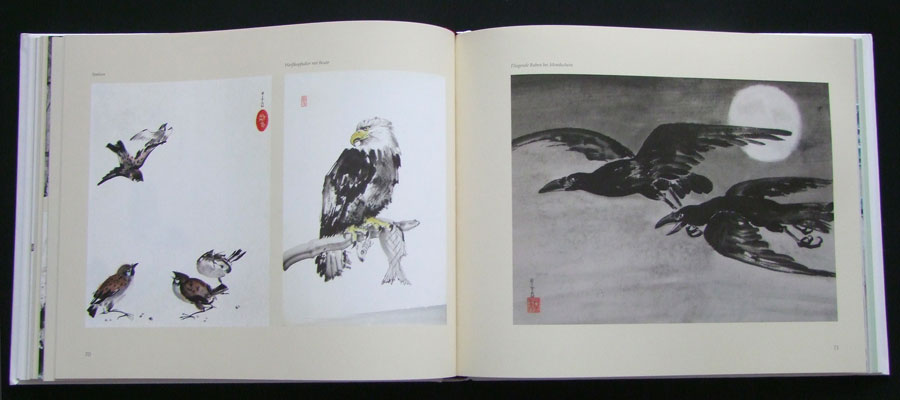“I dedicate this book to Nature – to every plant, animal, and landscape, all of which are an inexhaustable source of inspiration for me. This book is not meant to be didactic and does not contain descriptions of any painting techniques for self-instruction. It is my belief that the art of sumi-e can only be passed on to a student by an experienced master. But I hope that my book will convey the uniqueness and the beauty of sumi-e-painting, and that it will inspire others to learn this art. ”
Rita Böhm
Contents
- Sumi-e – Bridging East and West
- Introduction
- Artistic Principles
- A Guide to the Art of Living
- My Own Sumi-e
- Flower and Bird Paintings
- Landscape Paintings
- Zen Paintings
- Learning and Teaching Sumi-e Painting
- About the Artist
- Bibliography
Flower and Bird Paintings
Perhaps the significance of flower and bird painting lies in its ability to open our eyes to the secret behind every day phenomena.
The World of Birds
The world of birds has been a popular theme for East Asian ink painting since the ninth and tenth centuries, and was a predominant theme for the scholar painters. Birds are usually depicted in their natural environment: plants, branches of trees, bushes or flowers.
Quadrupeds and Water Creatures
The animal world depicted in paintings has on the one hand a (mythological) meaning beyond that of art per se, and on the other an artistic value of its own. Its outer appearance demands portrayal – thus, an aesthetic value is painted three-dimensionally as an actual artistic objective.
Landscape paintings
Since the first centuries of the Christian era, landscape, with all its thousands of shapes and faces, has been the main theme of East Asian ink painting. The landscape painting, as a phenomenon of the visual arts and human culture, and as an object of beauty in itself, came into being in China between the fourth and sixth centuries. In its art form, Nature is the measure of true beauty. By delving into Nature, human beings can become conscious of their mergence with the totality of Being, can understand the world and their place therein.
Zen paintings
The Zen painter recognizes every single creature and thing – even the most seemingly insignificant – as an all-embracing manifestation of the Buddha nature.
My intuitively dashed-off pictures, many of them executed while teaching, should trigger a similar experience in the mind of the student – an experience which a student must come to on his or her own, which cannot be >>given<< by the teacher.
Summary
Sumi-e, East Asian ink paintings inspired by Zen Buddhism, is an inspiration to art lovers not only in China and Japan but worldwide. This meditative, minimal, subjective art form is based on a deep, respectful feeling for nature, and points beyond its aesthetic value to high moral and religious ideals.
The free style of ink painting is composed of powerful, dynamic strokes of the brush. It expresses the Zen belief that enlightenment can come like a bolt of lightning. That which is hinted at is often of more importance than that which is painted. The sparseness of means, the reference to the essence of things – this is the heart of sumi-e painting. Sumi-e is more than an art form, it is also a spiritual path.
In this book, Rita Böhm, an international sumi-e master, demonstrates that an understanding of this noble art form can be accessible to anyone who feels inspiration or enjoyment in the contemplation of a sumi-e painting.
The over 150 monochromatic and colored works of sumi-e – flower, bird, landscape, and Zen paintings – are a repesentative cross-section of the lifework of this artist, who has been living and teaching in Berlin since 2002.
Rita Böhm
Sumi-e: Japanische Tuschmalerei – Kunst und Weg / Japanese Ink Painting – An Art and A Way
2011. 136 S. 24,80 EUR. Hardcover. 297 x 240 mm. ISBN 978-3-936366-36-5
Words in english and german
Bier’sche Verlagsgesellschaft
Asiatische Wege, Band 4








 Order now
Order now